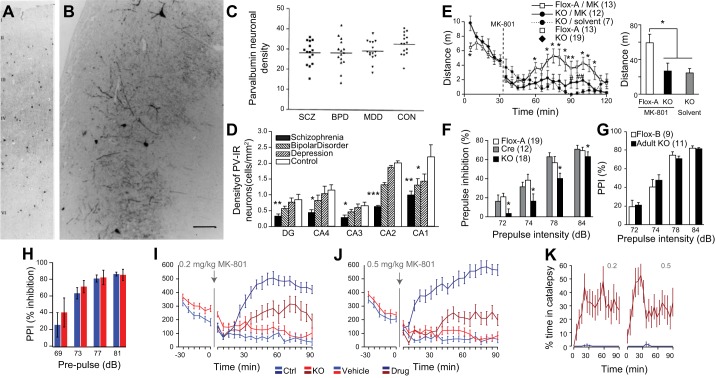FIGURE 24.
Parvalbumin-containing interneurons in schizophrenia. One of the most consistent findings from postmortem studies of patients with psychiatric disease is a reduced density of PV interneurons in cases of schizophrenia and, to lesser extent, bipolar disorder. PV-expressing neurons from human prefrontal cortex (A) and hippocampal region CA1 (controls) (B). PV cell density is significantly reduced in prefrontal cortex (C) and hippocampus in human psychiatric disease (D). Deleting the NMDAR subunit NR1 from GAD67-expressing interneurons (including PV interneurons) early in development causes a resistance to MK801-induced hyperlocomotion (E) and a reduction in prepulse inhibition (PPI) (F), implying that reduced NMDAR function in these cells is a cause of schizophrenia-like behaviors. However, deleting NR1 from the same neurons in adulthood fails to cause the same behavioral phenotypes (G), and PV interneuron-specific deletions of NR1 fail to cause deficits in PPI (blue: controls, red: KOs) (H). Mice with PV interneuron-specific deletions of NR1 show lower levels of hyperlocomotion than controls when dosed with MK801 at both 0.2 mg/kg (I) and 0.5 mg/kg (J), but this appears to be due to these animals displaying a greater sensitivity to MK801 and spending a large amount of time in a cataleptic state. These data suggest that NMDAR hypofunction in PV-containing interneurons is not an underlying factor in schizophrenia-like behavioral deficits, but that loss of functional NMDAR in PV-containing interneurons may actually be a risk factor instead of a cause of schizophrenia, by making neural circuits more susceptible to impaired NMDAR function in other types of neuron. [A and C adapted from Beasley et al. (77), with permission from Biological Psychiatry. B and D adapted from Zhang and Reynolds (1272), with permission from Schizophrenia Research. E– G from Belforte et al. (82), with permission from Nature Neuroscience. H–K from Bygrave et al. (155), with permission from Translational Psychiatry.]

